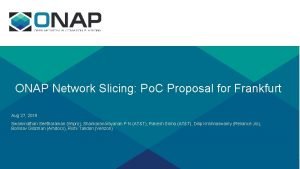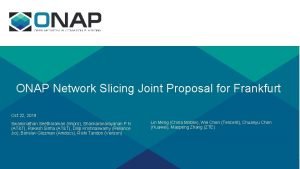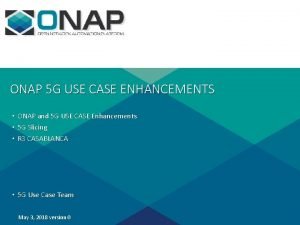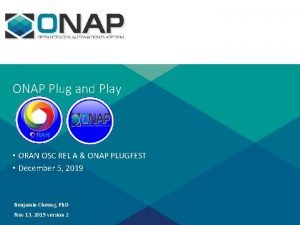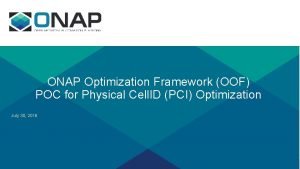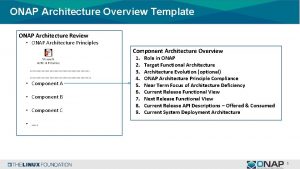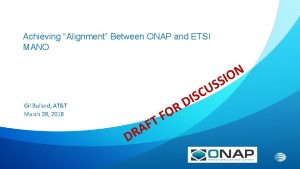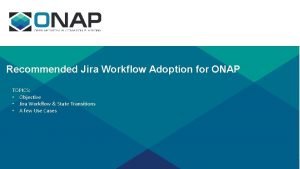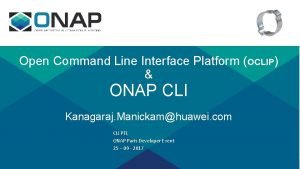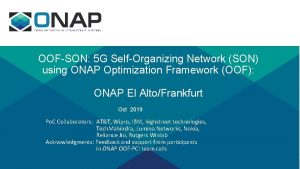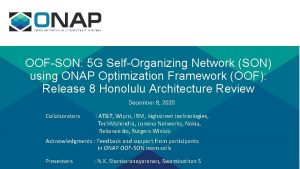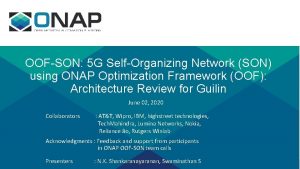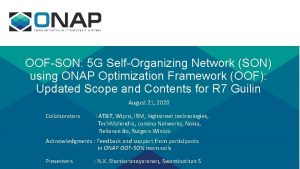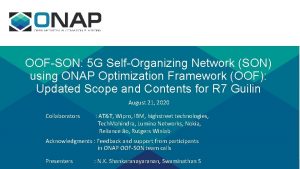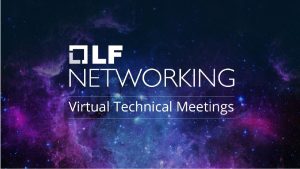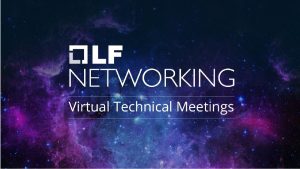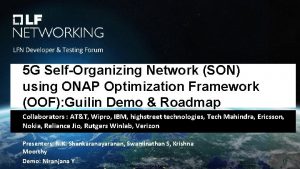OOFSON 5 G SelfOrganizing Network SON using ONAP











- Slides: 11

OOF-SON: 5 G Self-Organizing Network (SON) using ONAP Optimization Framework (OOF): Requirements Proposal for Guilin March 16, 2020 Collaborators : AT&T, Wipro, IBM, highstreet technologies, Tech. Mahindra, Lumina Networks, Nokia, Reliance Jio, Rutgers Winlab Acknowledgments : Feedback and support from participants in ONAP OOF-SON team calls Presenters : Shankaranayaranan N K, Swaminathan S

Summary of Requirements (Under Discussion) Category Requirement Content Priority Interoperability O-RAN alignment (VES, O 1 interface) Receive Configuration Management (CM) notifications over VES (instead of netconf) HIGH Functional RAN Database (Runtime Config DB), including any new RAN models 1. Data models/DB schema and APIs to be generated from yang models 2. Details of cells to be stored with PNF reference in AAI 3. Modeling of RAN functions and objects HIGH Platform Control Loop Coordination (CLC) extensions Collaborate on CLC extensions (queueing, priority, …) HIGH Functional Integration of SON and PNF onboarding functions 1. New cell(s) addition – extension to PNF onboarding & registration scenario, addition of new cell later to a PNF 2. Initial assignment of PCI to a cell Functional New SON function to evolve ONAP platform 1. SON based on data/KPI analysis 2. CLC interaction 3. Machine Learning (ML) aspects in DCAE Functional SON Lifecycle Role of SO, SDC, CLAMP (for SON service/feature deployment) LOW Interoperability Real g. NB interaction Interaction with real g. NB in lab LOW MEDIUM

ONAP SON alignment with O-RAN This has dependency on progress within O-RAN Simulated RAN ONAP DB schema &APIs generated from yang models • Centralized SON (c. SON) functions • Control Loop actions Config change • ~2000 Cells • Neighbor list, PCI O 1 - Netconf interface CM Notify VES FM/PM KPIs Guilin scope O 1 - VES outputs • Cells/GNBs • RIC • Yang model • Receive Config Management (CM) notification from RAN over (standardized) VES (Priority 1) • ONAP DB schema and APIs to be generated from associated ORAN network yang models (Priority 1) • Send Config change to RAN (to update neighbor list or PCI value) using O-RAN aligned yang models (Priority 2) Note: Substantial work in RAN Simulator to develop/test/demo ONAP functionality

ONAP SON alignment with O-RAN

ONAP RAN Database (Runtime Config DB) • Objectives o Build upon 5 G SON RAN Database started in Dublin & Frankfurt o Collaborate with (new) Rel 7 Runtime Config DB project to make this a shared ONAP functionality • Dependencies o Availability of O-RAN yang models and VES specification o Runtime Config DB, DCAE Frankfurt (Release 6) Guilin (Release 7) RAN database Config. DB (part of SDN-C CCSDK) Runtime Config DB (RCDB) (New Rel 7 function) Config (CM) notification Pre-standard VES message ORAN standard VES CM Notify message CM Notify processing RANSim –> DMaa. P -> SDNR RANSim -> DCAE -> DMaa. P -> SDNR CM update SDNR -> Config. DB SDNR -> RCDB

Control Loop Coordination Illustration of CLC with queuing Optimization (OOF) 2 b 2 a CL 2 2 c Co-ordination, Decisions (Policy) 1 b Data Collection, 1 a & Analysis (DCAE) 1 c 2 d 1 f • Build further on Frankfurt work to enhance Platform capabilities, for example: - Queueing/de-queueing (illustrated in the figure) - Discard outdated loop actions - Prioritization/pre-emption Action (SDN-R) ORAN Radio Network 2 e 1 d (Near RT) RIC A-1/O-1 Control Loop 2 A-1/O-1 RIC (non-RT) FM, PM, CM • Collaborate with Policy/Control Loop Team for extensions to Control Loop Coordination (CLC) 1 e • CLC has much wider implications to ONAP as a platform, and not just restricted in scope to SON use cases

Design SON Lifecycle – Cell addition/configuration 1 PNF Modeling 2 Run-Time (Instances) PNF Instance Declaration 3 PNF Boot-strapping 4 5 PNF Contacts ONAP PNF Activation 6 Cell Configuration (for SON) Resources Definition/Services Definition SDC: PNF (physical element) Modeling Distribution of types PNF Infrastructure Service Declaration First part of PNF instantiation DCAE & AAI Entry with PNF ID (e. g. MAC address) • New cell addition by ONAP – extend PNF Plug-and-play use case • Assign initial PCI value (any other configuration? ) • Points for further analysis and discussion PNF Powers up and Boot-straps PNF performs a “Plug and Play” procedure Equipment vendor proprietary steps PNF connects to ONAP via a Registration Event PNF Registration Handler (PRH) processes the event Connection points configured Second part of PNF service instantiation PNF configured and ready to provide service New cells configured & manageable from ONAP Include PCI assignment to cells associated with PNF and update NR info from cells - Modeling of RAN “Cell” in ONAP - ‘Discovery’ of a new cell (provided by PNF? ) and subsequent configuration (by ONAP? ) before it is active; removal of a cell (disassociate from PNF) - Handling of “shared”/”virtual” cells - O-RAN alignment • Cell discovery, initial configuration, new cell addition/removal later, initial PCI assignment - Initial NR details update in ONAP (topology discovery? )

Other requirements (under investigation) • New SON use case to extend ONAP platform capabilities o Handle large volume of real-time data (HV-VES), and process it o Application of ML in ONAP (specifically in Control Loops) o CLC • SON Lifecycle o Role of SDC, SO and AAI for “ONAP SON Service” o Deployment of Control Loop via CLAMP o Instantiation of SON-Handler MS when the first cell is activated • Interaction with real g. NB and/or O-RAN software components

Business Drivers Executive Summary SON (Self-Organizing Networks) functionality is an essential part of 4 G networks, and will be even more critical for 5 G. SON enables automation to improve network performance and efficiency, improve user experience, and reduce operational expenses and complexity. The objective of the OOF SON use cases is to develop an ONAP-based SON platform using the ONAP Optimization Framework (OOF). We have taken a phased approach since SON is complex, and SON for 5 G is still evolving. We started with the Physical Cell Identity (PCI) optimization SON use case in Casablanca, and added centralized Automated Neighbor Relations (ANR) aspects in Dublin. In Frankfurt, we included adaptive SON functionality, took initial steps in O-RAN alignment and collaborated with Policy Control Loop Co-ordination (CLC). For Guilin, we will align with ORAN interfaces, be the early adopter of the new Runtime Config DB (e. g. generate DB schemas and APIs based on yang models), cover SON-related workflow for new cell addition, introduce another SON use case to add new platform capabilities, and collaborate on further extensions to CLC. We will also pursue alignment with industry trends for open interfaces & open models for RAN interactions, in particular with O-RAN. Business Impact SON is an essential feature in mobile networks, and relevant to every operator. Any ONAP-based network deployment for 5 G will benefit from an ONAP-based SON solution, which provides a disaggregation of SON functions into modules aligned with the ONAP architecture. Operators and vendors will both benefit from the ability of vendors to bring best-in-class solutions to each module, while leveraging the benefits of a community-supported open platform. This will enable faster development of innovative solutions. The approach taken could very well be evolved to address SON use cases whose scope extends beyond just the RAN.

Business Markets SON for 5 G is relevant to all 5 G operators and markets. Funding/Financial Impacts SON functions reduce OPEX since the automated self-organizing functions are an efficient approach to continuously optimize network configurations to improve performance and respond to network conditions. Organization Mgmt, Sales Strategies There are no additional organizational management or sales strategies for this beyond whatever is required for ONAP deployment to support 5 G.

s Thank You!
